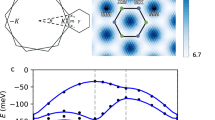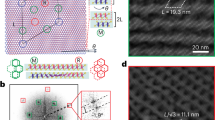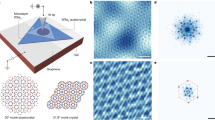Abstract
In twisted bilayers of semiconducting transition metal dichalcogenides, a combination of structural rippling and electronic coupling gives rise to periodic moiré potentials that can confine charged and neutral excitations1,2,3,4,5. Here we show that the moiré potential in these bilayers at small angles is unexpectedly large, reaching values above 300 meV for the valence band and 150 meV for the conduction band—an order of magnitude larger than theoretical estimates based on interlayer coupling alone. We further demonstrate that the moiré potential is a non-monotonic function of moiré wavelength, reaching a maximum at a moiré period of ~13 nm . This non-monotonicity coincides with a change in the structure of the moiré pattern from a continuous variation of stacking order at small moiré wavelengths to a one-dimensional soliton-dominated structure at large moiré wavelengths. We show that the in-plane structure of the moiré pattern is captured by a continuous mechanical relaxation model, and find that the moiré structure and internal strain, rather than the interlayer coupling, are the dominant factors in determining the moiré potential. Our results demonstrate the potential of using precision moiré structures to create deeply trapped carriers or excitations for quantum electronics and opto-electronics.
This is a preview of subscription content, access via your institution
Access options
Access Nature and 54 other Nature Portfolio journals
Get Nature+, our best-value online-access subscription
$29.99 / 30 days
cancel any time
Subscribe to this journal
Receive 12 print issues and online access
$209.00 per year
only $17.42 per issue
Buy this article
- Purchase on Springer Link
- Instant access to full article PDF
Prices may be subject to local taxes which are calculated during checkout




Similar content being viewed by others
Data availability
Data that support the plots within this paper and other findings of this study are available from the corresponding author upon reasonable request. Source data are provided with this paper.
References
Seyler, K. L. et al. Signatures of moiré-trapped valley excitons in MoSe2/WSe2 heterobilayers. Nature 567, 66–70 (2019).
Wu, F. et al. Theory of optical absorption by interlayer excitons in transition metal dichalcogenide heterobilayers. Phys. Rev. B 97, 035306 (2018).
Tran, K. et al. Evidence for moiré excitons in van der Waals heterostructures. Nature 567, 71–75 (2019).
Wang, L. et al. Correlated electronic phases in twisted bilayer transition metal dichalcogenides. Nat. Mater. 19, 861–866 (2020).
Wang, J. et al. Excitonic phase transitions in MoSe2/WSe2 heterobilayers. Preprint at https://arxiv.org/pdf/2001.03812.pdf (2020).
Regan, E. C. et al. Mott and generalized Wigner crystal states in WSe2/WS2 moiré superlattices. Nature 579, 359–363 (2020).
Wang, Z. et al. Evidence of high-temperature exciton condensation in two-dimensional atomic double layers. Nature 574, 76–80 (2019).
Wu, F. et al. Hubbard model physics in transition metal dichalcogenide moiré bands. Phys. Rev. Lett. 121, 026402 (2018).
Zhang, Y. et al. Moiré quantum chemistry: charge transfer in transition metal dichalcogenide superlattices. Phys. Rev. B 102, 201115 (2020).
Yu, H. et al. Moiré excitons: from programmable quantum emitter arrays to spin–orbit-coupled artificial lattices. Sci. Adv. 3, e1701696 (2017).
Ruiz-Tijerina, D. A. et al. Interlayer hybridization and moiré superlattice minibands for electrons and excitons in heterobilayers of transition-metal dichalcogenides. Phys. Rev. B 99, 125424 (2019).
Geng, W. et al. Moiré potential, lattice corrugation and band gap spatial variation in a twist-free MoTe22/MoS2 heterobilayer. J. Phys. Chem. Lett. 11, 2637–2646 (2020).
Zhang, C. et al. Interlayer couplings, moiré patterns, and 2D electronic superlattices in MoS2/WSe2 hetero-bilayers. Sci. Adv. 3, e1601459 (2017).
Pan, Y. et al. Quantum-confined electronic states arising from the moiré pattern of MoS2-WSe2 heterobilayers. Nano Lett. 18, 1849–1855 (2018).
Zhang, Z. et al. Flat bands in twisted bilayer transition metal dichalcogenides. Nat. Phys. 16, 1093–1096 (2020).
Li, H. et al. Imaging moiré flat bands in 3D reconstructed WSe2/WS2 superlattices. Preprint at https://arxiv.org/pdf/2007.06113.pdf (2020).
Rosenberger, M. R. et al. Twist angle-dependent atomic reconstruction and moiré patterns in transition metal dichalcogenide heterostructures. ACS Nano 14, 4550–4558 (2020).
Weston, A. et al. Atomic reconstruction in twisted bilayers of transition metal dichalcogenides. Nat. Nanotechnol. 15, 592–597 (2020).
Halbertal, D. et al. Moiré metrology of energy landscapes in van der Waals heterostructures. Nat. Commun. 12, 242 (2021).
Maity, I. et al. Reconstruction of moiré lattices in twisted transition metal dichalcogenide bilayers. Preprint at https://arxiv.org/pdf/1912.08702.pdf (2019).
Enaldiev, V. et al. Stacking domains and dislocation networks in marginally twisted bilayers of transition metal dichalcogenides. Phys. Rev. Lett. 124, 206101 (2020).
Edelberg, D. et al. Tunable strain soliton networks confine electrons in van der Waals materials. Nat. Phys. 16, 1097–1102 (2020).
Bai, Y. et al. Excitons in strain-induced one-dimensional moiré potentials at transition metal dichalcogenide heterojunctions. Nat. Mater. 19, 1068–1073 (2020).
Naik, M. H. et al. Ultraflatbands and shear solitons in moiré patterns of twisted bilayer transition metal dichalcogenides. Phys. Rev. Lett. 121, 266401 (2018).
Wilson, N. R. et al. Determination of band offsets, hybridization and exciton binding in 2D semiconductor heterostructures. Sci. Adv. 3, e1601832 (2017).
Edelberg, D. et al. Approaching the intrinsic limit in transition metal diselenides via point defect control. Nano Lett. 19, 4371–4379 (2018).
Kresse, G. et al. Efficient iterative schemes for ab initio total-energy calculations using a plane-wave basis set. Phys. Rev. B 54, 11169–11186 (1996).
Kresse, G. et al. From ultrasoft pseudopotentials to the projector augmented-wave method. Phys. Rev. B 59, 1758–1775 (1999).
Perdew, J. P. et al. Generalized gradient approximation made simple. Phys. Rev. Lett. 77, 3865–3868 (1996).
Klimeš, J. et al. Van der Waals density functionals applied to solids. Phys. Rev. B 83, 195131 (2011).
Carr, S. et al. Relaxation and domain formation in incommensurate two-dimensional heterostructures. Phys. Rev. B 98, 224102 (2018).
Grimme, S. et al. A consistent and accurate ab initio parametrization of density functional dispersion correction (DFT-D) for the 94 elements H-Pu. J. Chem. Phys. 132, 154104 (2010).
Acknowledgements
We thank S. Carr and E. Kaxiras for providing the GSFE function for relaxation calculations. We thank C. Dean, L. Fu, M. Jain, I. Maiti, Q. Shi and Y. Zhang for useful discussions. This work is supported by the Programmable Quantum Materials (Pro-QM) programme at Columbia University, an Energy Frontier Research Center established by the Department of Energy (grant no. DE-SC0019443). STM experiments were supported by the Air Force Office of Scientific Research via grant no. FA9550-16-1-0601 (S.S. and A.N.P.). Synthesis of MoSe2 and WSe2 was supported by the National Science Foundation Materials Research Science and Engineering Centers programme through Columbia in the Center for Precision Assembly of Superstratic and Superatomic Solids (DMR-1420634). D.H. was supported by a grant from the Simons Foundation (579913). DFT calculations were performed with the support of the National Natural Science Foundation of China (grants nos. 11774084 and U19A2090, to M.C.).
Author information
Authors and Affiliations
Contributions
S.S. performed STM experiments, assisted by S.L. D.H. performed relaxation calculations. W.W. performed SHG experiments. M.C. performed DFT calculations. J.H., W.Y., D.N.B., X.Z. and A.N.P. provided advice. Data analysis and manuscript preparation were performed by S.S. and A.N.P. with input from all coauthors.
Corresponding author
Ethics declarations
Competing interests
The authors declare no competing interests.
Additional information
Peer review information Nature Physics thanks Brian LeRoy and the other, anonymous, reviewer(s) for their contribution to the peer review of this work.
Publisher’s note Springer Nature remains neutral with regard to jurisdictional claims in published maps and institutional affiliations.
Supplementary information
Supplementary Information
Supplementary discussion.
Source data
Source Data Fig. 2
Source data of spectroscopy for different moiré wavelengths.
Source Data Fig. 3
Source data of the position of the band edges.
Source Data Fig. 4
Source data for the moiré potential as a function of moiré wavelength, strain tensor components and maximal shear strain as a function of moiré wavelength.
Rights and permissions
About this article
Cite this article
Shabani, S., Halbertal, D., Wu, W. et al. Deep moiré potentials in twisted transition metal dichalcogenide bilayers. Nat. Phys. 17, 720–725 (2021). https://doi.org/10.1038/s41567-021-01174-7
Received:
Accepted:
Published:
Issue Date:
DOI: https://doi.org/10.1038/s41567-021-01174-7
This article is cited by
-
Engineering interlayer hybridization in van der Waals bilayers
Nature Reviews Materials (2024)
-
Electrostatic moiré potential from twisted hexagonal boron nitride layers
Nature Materials (2024)
-
Engineering correlated insulators in bilayer graphene with a remote Coulomb superlattice
Nature Materials (2024)
-
Dynamically tunable moiré exciton Rydberg states in a monolayer semiconductor on twisted bilayer graphene
Nature Materials (2024)
-
Unveiling strain-enhanced moiré exciton localization in twisted van der Waals homostructures
Nano Research (2024)



